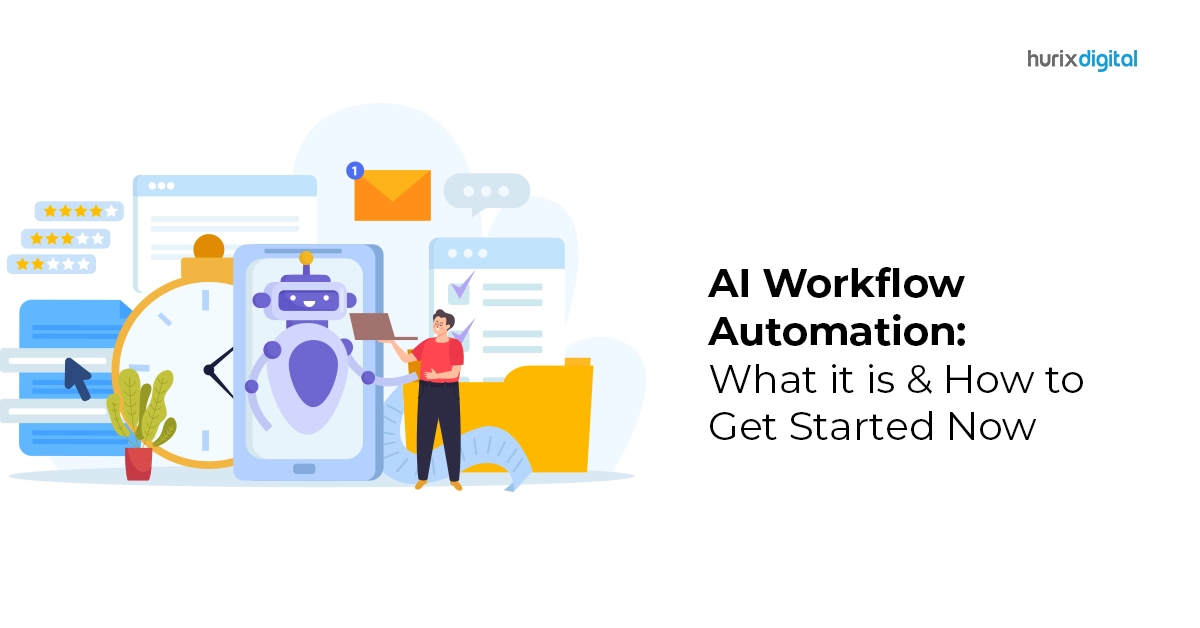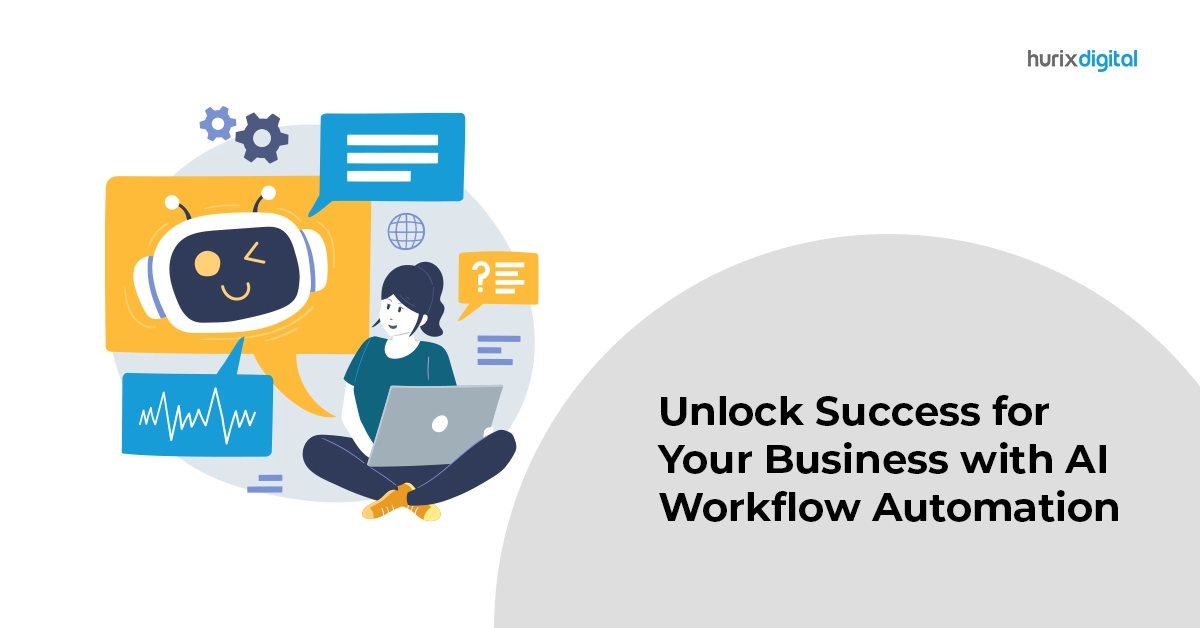Summary
This article provides an overview of AI workflow automation. It defines what AI workflow automation is and the benefits of incorporating AI in your business processes. It also covers the business uses cases for AI process automation and the tasks you can perform with AI software.
Artificial Intelligence (AI) has become a key player in several aspects of our lives, the business industry being no exception. One intriguing application of AI is in the workflow automation of business processes.
Organizations can now automate time-consuming and repetitive tasks thanks to AI-powered automation software. This technology is a game-changer for enterprises looking to boost efficiency and cut costs.
Whatever your industry or size, AI workflow automation will profoundly and permanently change how your business functions. With over 50% of companies adopting AI in at least one business area in 2022, the AI revolution is gaining momentum.
This article explores the endless possibilities of AI workflow automation and how it can transform your business.
Table of Contents:
- What Is AI Workflow Automation?
- Benefits of AI Workflow Automation
- Business Uses Cases for AI Process Automation
- What Tasks Can You Automate With AI Software?
- How to Get Started With AI Workflow Automation?
- Wrapping Up!
What Is AI Workflow Automation?
AI workflow automation uses artificial intelligence to streamline and improve existing business processes that are often tedious. From creating records, sending emails, approving requests, and conducting big data analyses, automation intelligent software can perform various tasks within a workflow.
It usually does it faster than humans and offers additional benefits. Business automation aims to reduce employees’ workload and enhance productivity. Automated workflows also allow your team to focus on more complex and strategic tasks.
Benefits of AI Workflow Automation
There are several advantages to incorporating AI in your workflows:
1. Cost Savings
AI software can perform tasks at a lower cost than humans while delivering the same quality or better results. This reduces labor and overhead costs. Moreover, as humans are more prone to error than AI tools, less money and time are required to fix these mistakes, saving businesses money in the long run.
2. Improved Efficiency
With AI workflow automation, enterprises can now speed up and simplify tasks that once required significant time and effort. Automating repetitive and strenuous tasks frees up valuable human resources for more complex and creative work, increasing efficiency, productivity, and innovation.
For instance, an enterprise integrating chatbots into its customer success program can help address customer concerns more accurately and quickly. This improved efficiency leads to higher customer satisfaction and loyalty, allowing customer success representatives to focus on more complex problem-solving.
3. Better Data Analytics
AI workflow tools can quickly process large amounts of data and provide accurate analysis that humans cannot offer. They provide real-time insights and feedback, enabling businesses to make timely, data-driven decisions. Ultimately, this means better business outcomes and increased profitability.
4. Improved Time-to-Market
Process automation helps companies handling huge volumes of manual tasks adapt to market changes quickly. It enables them to test and launch products or services before their competitors. A faster time-to-market helps increase market share and revenue, enhance customer satisfaction, and improve agility.
Also Read: How Intelligent Automation (RPA+AI) will Revolutionize Business Processes?
Business Uses Cases for AI Process Automation
So, where exactly can your business integrate automation into its workflow?
1. Sales and Marketing (Department Use Case)
Sales professionals can use AI workflow tools to create, identify, and qualify leads. AI can also score and prioritize leads for follow-ups. This helps close more deals in less time.
AI software helps marketing teams identify customer segments and create targeted campaigns. Predicting marketing trends, future sales, and customer behavior becomes simplified with AI workflow automation.
2. Manufacturing (Industry-specific Use Case)
Manufacturers use automation software to streamline production. They can automate the following processes to boost efficiency:
- AI helps in quality control by identifying defects in materials or products.
- It helps avoid downtime by performing predictive maintenance and monitoring equipment for signs of failure.
- Automated inventory management systems can use AI to predict future needs and maintain stock levels. This keeps production moving and helps avoid shortages.
What Tasks Can You Automate with AI Software?
There are several things you can accomplish with AI workflow automation. It all depends on your team’s objectives. Below are a few examples:
- Interactive Presentations: AI tools can help create engaging presentations for audiences on the preferred subject or document. This saves significant time for presenters.
- Personalized Sales Emails: The sales process is tedious and repetitive. It’s no wonder that sales teams often experience burnout. Here’s when AI software comes to their rescue. AI tools analyze customer data and create personalized sales emails, saving time and increasing the chances of making a sale.
- SEO Content: With mounting competition in the ever-expanding world of SEO, content marketers are working to cut through the noise. AI tools can help your content rank higher in search results by generating SEO-friendly content based on phrases and keywords. This saves time for content teams, enabling them to tackle SEO strategically.
How to Get Started with AI Workflow Automation?
Setting up AI workflow automation involves a series of steps to plan, implement, and optimize the process. Below is a short guide that can help you get started.
1. Identify the Workflow
Start by defining the workflow that can benefit from automation. Compare current task outcomes with the desired results.
Check which parts of the process require human intervention and which can be automated. Identify the bottlenecks and look for areas where automation can improve the return on investment (ROI).
2. Select the Best AI Tools
Choose the appropriate AI tool for the process depending on the identified use case. As various options are available in the market, selecting a tool that meets your specific needs is crucial.
The best tool has all the necessary features like customizable workflows, seamless automation, an intuitive interface, easy integration, and automated routing.
3. Implement Automation
This is the step where you transform complex procedures into streamlined workflows. Use the process mapping done earlier to create each step of the workflow. You can seek professional help to configure the chosen AI tool and assign relevant employees to each step for the best results.
4. Test and Improve
This is one of the most important steps where you eliminate malfunctions or issues. Once you set up the automation, test the workflow in different ways to ensure it runs as expected.
If an error pops up, you can ask your technology partner to fix it or make adjustments. Gather feedback from the team members to further customize and improve the setup.
Wrapping Up!
AI workflow automation has opened countless opportunities by streamlining operations and enhancing long-term efficiency and productivity.
The best approach to AI workflow automation is collaborating with a reliable technology partner. Whether you require support in technical setup, need consultations, or want to create a strategy, Hurix Digital can help you in every step of the journey.
Our team of seasoned professionals can help you create a customized system tailor-made to your requirements. Schedule a demo with us today and experience the power of AI workflow automation yourself!







